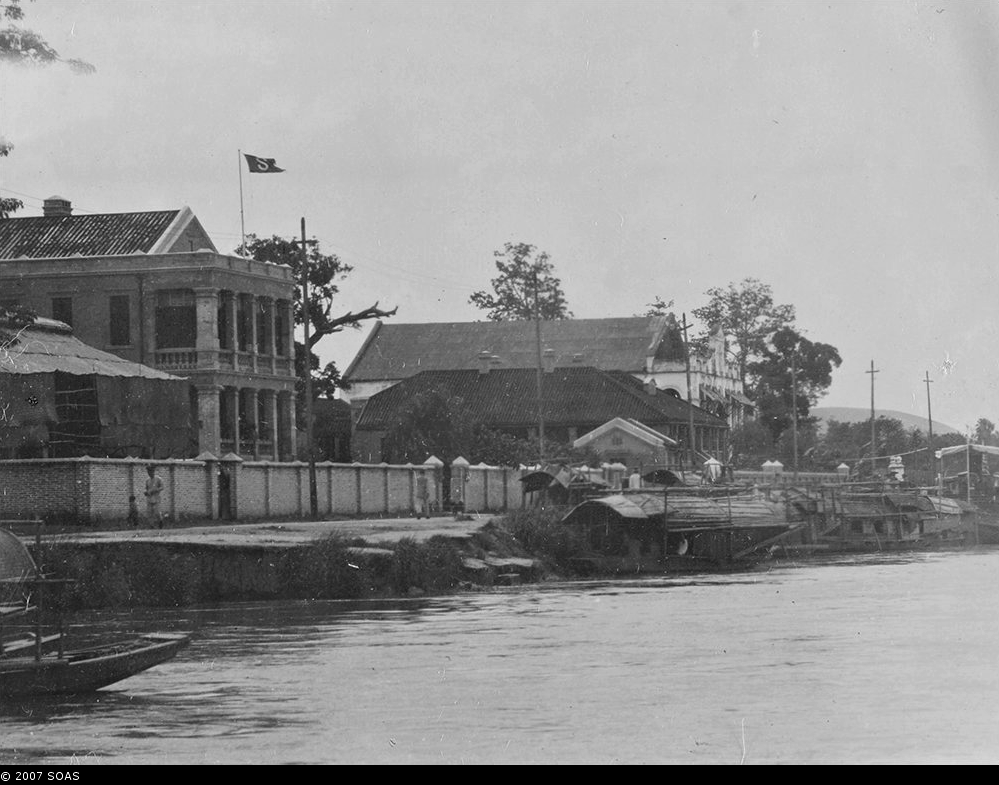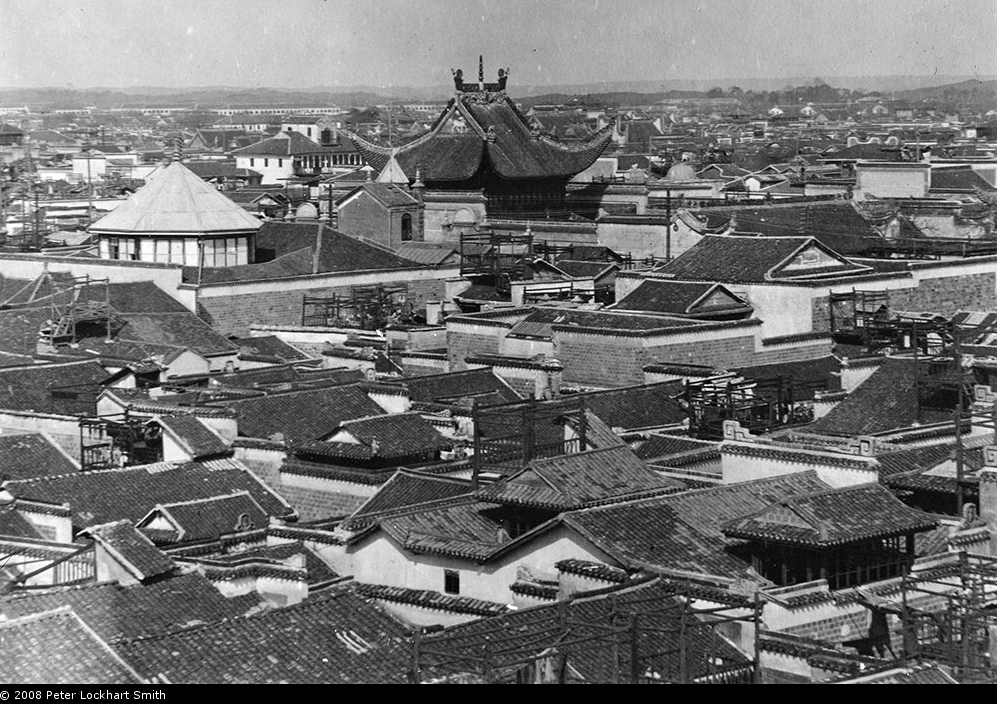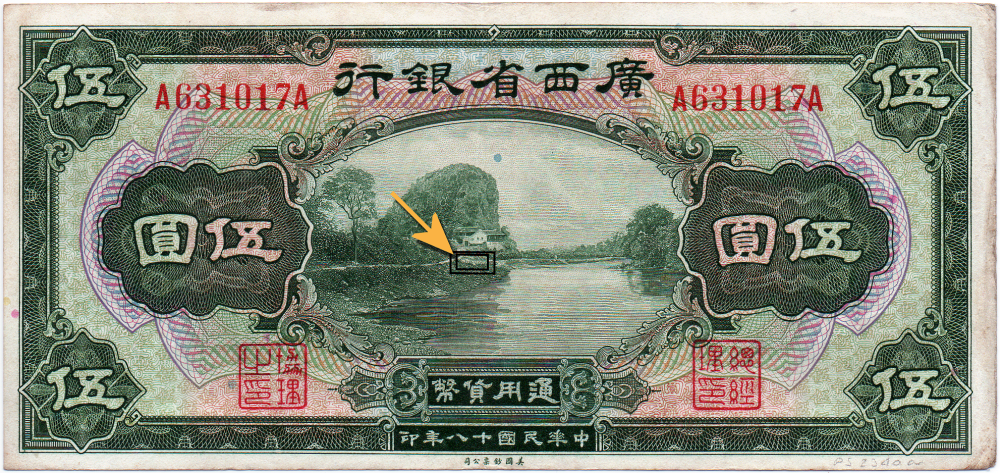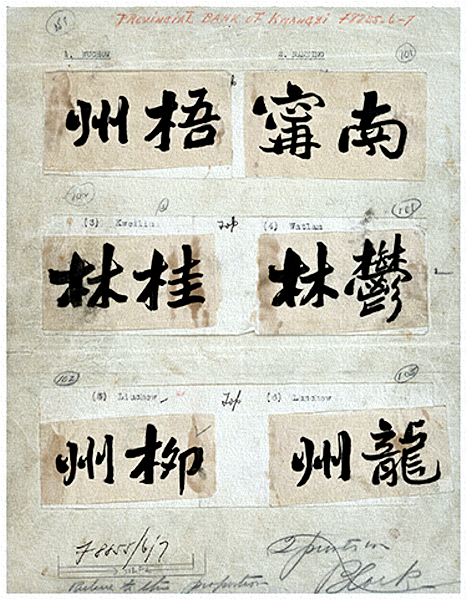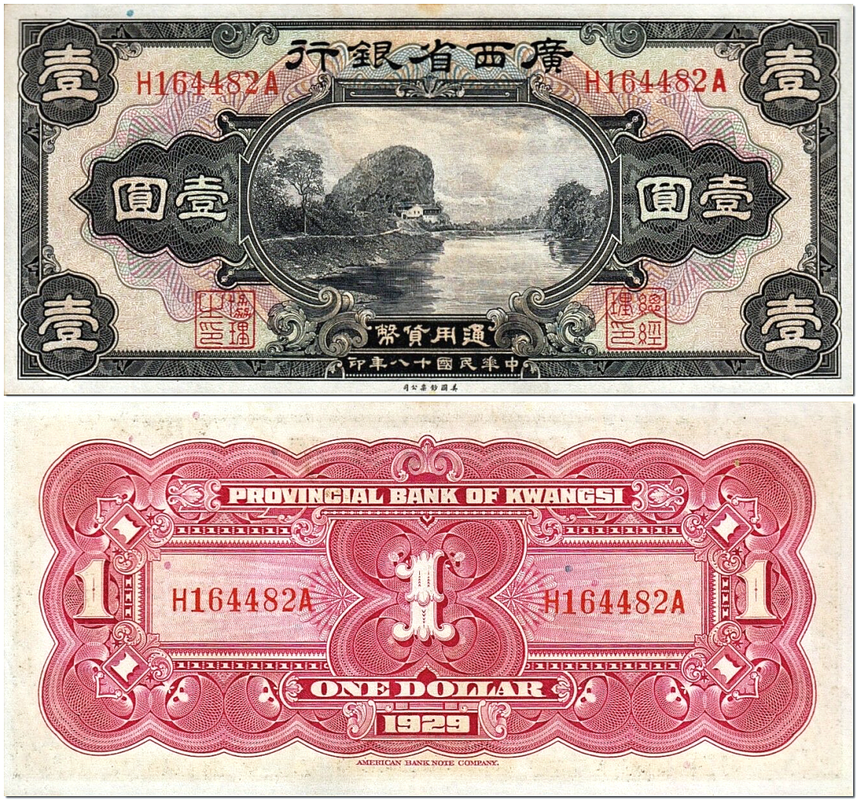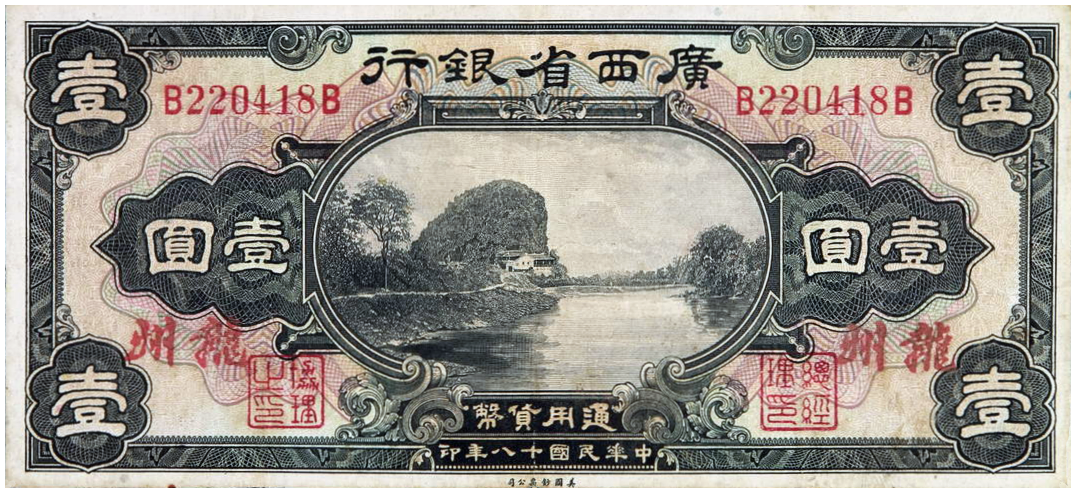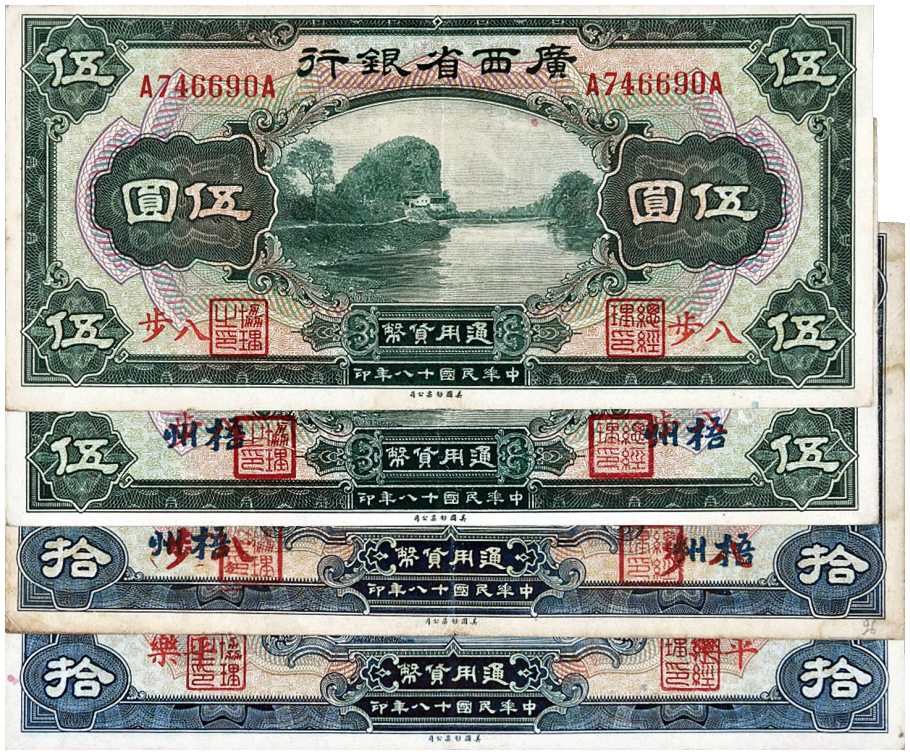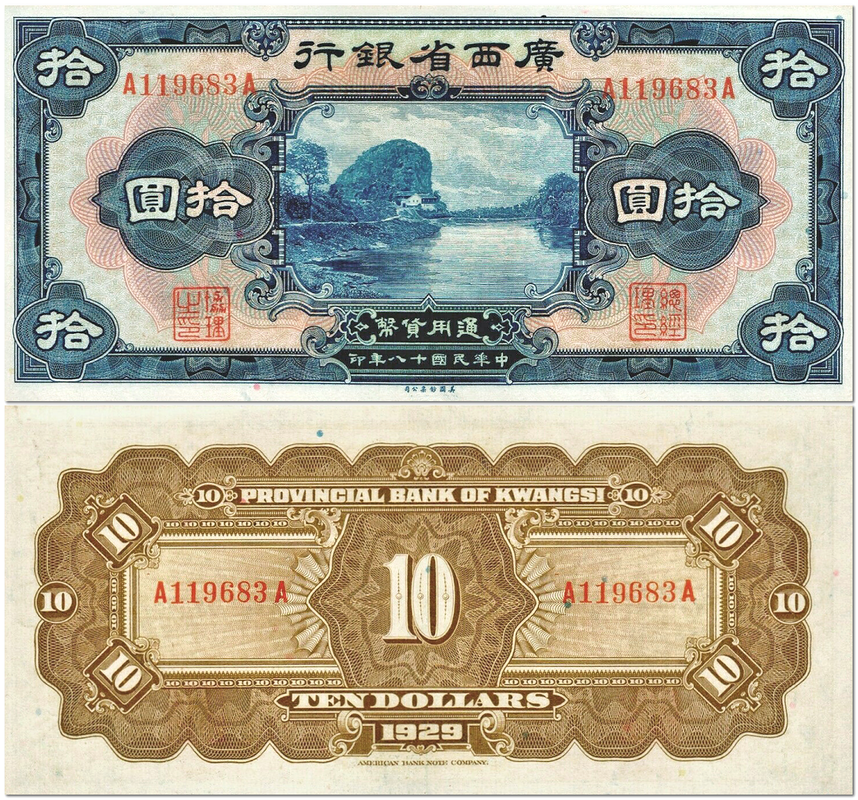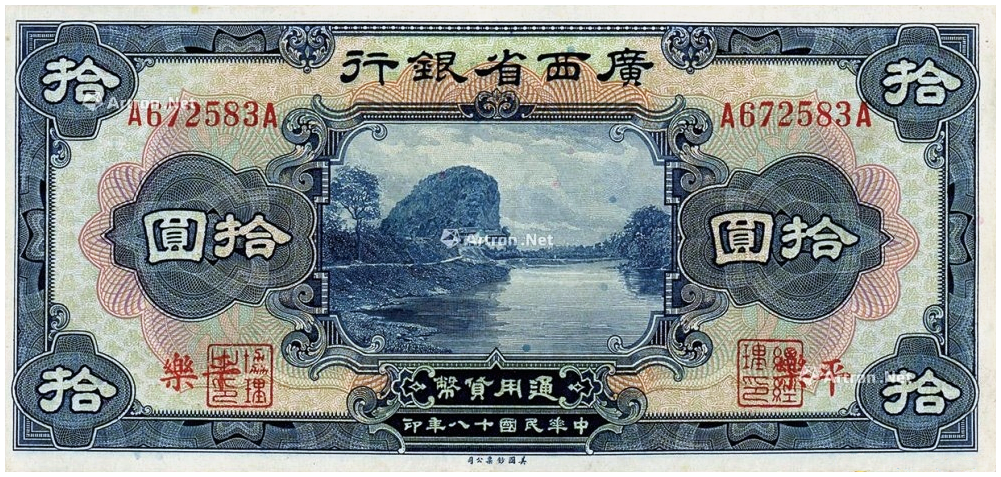|
October 17 2021
|
The Provincial Bank of Kwangsi (Guangxi) - 廣西省銀行
The paper money issues of 1929 - 年八十國民華中
A study of the 1929 issues of the Provincial Bank of Kwangsi, printed by the American Banknote Company (ABNCo).
As is often the case with Chinese currency, this apparently straightforward series of 3 denominations is somewhat more complex than it seems, due to the branch issue variations and apparent flaws in some existing catalogs.
An introduction to Kwangsi and its branch of issue cities/regions
As is often the case with Chinese currency, this apparently straightforward series of 3 denominations is somewhat more complex than it seems, due to the branch issue variations and apparent flaws in some existing catalogs.
An introduction to Kwangsi and its branch of issue cities/regions
Kwangsi/Kwangse (Guangxi) 廣西 province
|
Kwangsi (or Kwangse, Guangxi) is a former province - since 1958, an autonomous region - of South China, bordering with Vietnam. The name roughly translates to "western expanse". The region was considered wild and unruly, with conflicts and revolts common during the Ming Dynasty, and through the 19th century under the Qing.
Following the Wuchang Uprising, Kwangsi (Guangxi) seceded from the Qing Empire on 6 November 1911. The Qing governor, Shen Bingdan, initially remained in place, but was subsequently removed by a mutiny commanded by General Lu Rongting. Later feuding with Sun Yat-sen led to defeat in the 1920 and 1921 Kwangtung-Kwangsi (Guangdong–Guangxi) War. After a brief occupation by Chen Jiongming's Cantonese forces, Kwangsi fell into disunity and banditry for several years until warlord Li Zongren's Guangxi Pacification Army established the New Kwangsi clique dominated by Li, Huang Shaohong, and Bai Chongxi. |
|
The city of Baise 百色 (Bose, Baksaek) was at the centre of the Baise Uprising, a failed Communist revolt led by Chen Zhaoli and Deng Xiaoping in 1929, against the Nationalist Government. There is most likely a connection between this and the scarce Baise placename notes which are part of the 1929 Kwangsi Provincial Bank series.
Kweilin 桂林 (Guilin) is an ancient city, the site inhabited under various names for well over 2000 years. In 1921, Kweilin became one of the headquarters of the Northern Expeditionary Army led by Sun Yat-sen in his campaign to retake China from the control of the corrupt warlord dominated Peking (Beijing) government. The city was the capital of Kwangsi Province from 1936 until 1950. |
Above: Pontoon over the Li River at Kweilin, Reginald Hedgeland, c1913-1921.
© 2007 SOAS. University of Bristol Library (www.hpcbristol.net)
© 2007 SOAS. University of Bristol Library (www.hpcbristol.net)
Liuchow 柳州 (Liuzhou): an ancient city on the banks of the Liu River, first established in 111 BCE. During most of the Ming period (1368–1644) it was little more than a frontier garrison and trading post, often used as a place of exile. Only in the 17th century did the area become dominated by Han Chinese settlers. Liuchow has long been a centre for the trade of agricultural products, timber, and oils.
Lungchow 龍州 (龙州) (Longzhou): a rural town near the Vietnamese border that was more important during the first half of the 20th century than perhaps now. A French consulate (still standing) was established here in the 1890s, but went out of use by 1948.
Below: The iron bridge over the Tso Kiang, Lungchow, c1913-1930, Reginald Hedgeland
© 2007 SOAS. University of Bristol Library (www.hpcbristol.net)
Lungchow 龍州 (龙州) (Longzhou): a rural town near the Vietnamese border that was more important during the first half of the 20th century than perhaps now. A French consulate (still standing) was established here in the 1890s, but went out of use by 1948.
Below: The iron bridge over the Tso Kiang, Lungchow, c1913-1930, Reginald Hedgeland
© 2007 SOAS. University of Bristol Library (www.hpcbristol.net)
Nanning 南寧: currently the capital of Kwangsi (Guangxi), since 1949. Another ancient and historic city, and a significant trade centre, founded on the north bank of the Yong River. Opened to foreign trade by Qing authorities in 1907, Nanning grew rapidly. It was also the provincial capital during 1912-1936.
Pa Pu 八步 (Babu), a small rural city and now a district of historic Hezhou city.
Pingle County 平乐 (平樂), a county and town south-east of and close to Kweilin (Guilin), which currently has administrative authority.
Watlam 鬱林 (玉林) (Yulin): since ancient times, Yulin has been important for trade and communications between central China and the south, especially along the coast of the Tonkin Gulf.
Pingle County 平乐 (平樂), a county and town south-east of and close to Kweilin (Guilin), which currently has administrative authority.
Watlam 鬱林 (玉林) (Yulin): since ancient times, Yulin has been important for trade and communications between central China and the south, especially along the coast of the Tonkin Gulf.
Wuchow 梧州 (Wuzhou): the first county administration was established here in 111 BCE under the name of Guangxin. In 621 CE it become Wuchow (Wuzhou). The city was opened to foreign commerce in 1897, after which trade with Germany and the United Kingdom developed and flourished. Industrial growth began in the 1920s and ’30s, when numerous chemical plants were established.
Below (left and right): two views of Wuchow (Wuzhou), c1915, by the Banister Family.
© 2008 Peter Lockhart Smith. University of Bristol Library (www.hpcbristol.net)
Below (left and right): two views of Wuchow (Wuzhou), c1915, by the Banister Family.
© 2008 Peter Lockhart Smith. University of Bristol Library (www.hpcbristol.net)
The Kwangsi Provincial Bank
There is little information readily accessible for this institution established in 1910 as the official bank and money issuer for the provincial government. Different spellings of the name - Kwangsi/Kwangse - and varieties of the English form of the title have caused confusion over the years, but there was certainly only one provincial bank operating in Kwangsi (Guangxi) at a time, though split into successive phases of operation. The first phase of the bank seems to have ended around 1920 due to overissue of notes to support the Zhili–Anhui War for the control of the Beiyang government in Peking (Beijing), rendering the currency virtually worthless.
At some point by 1926, the bank was re-established and issuing currency by an unidentified regional printer for at least 8 named branches, plus an unmarked issue (see SCWPM S2325 - S2327). This series also uses a variety of colours for different branch/place names, a scheme which was continued/expanded with the 1929 series printed by the American banknote Co. which is the focus of this article.
At some point by 1926, the bank was re-established and issuing currency by an unidentified regional printer for at least 8 named branches, plus an unmarked issue (see SCWPM S2325 - S2327). This series also uses a variety of colours for different branch/place names, a scheme which was continued/expanded with the 1929 series printed by the American banknote Co. which is the focus of this article.
The Currency:
(front) rural river scene with rock outcrop and buildings: a limestone karst, and what is possibly a temple beside the Li River near Kweilin (Guilin), Lijiang. Based on an as yet unidentified photograph. Texts in Chinese. (back) patterned borders and amount, texts in English.
Printer: American Banknote Company
Below: the placement of the American Banknote Company copyright of the central vignette (and a closer look at the suspected temple complex).
(front) rural river scene with rock outcrop and buildings: a limestone karst, and what is possibly a temple beside the Li River near Kweilin (Guilin), Lijiang. Based on an as yet unidentified photograph. Texts in Chinese. (back) patterned borders and amount, texts in English.
Printer: American Banknote Company
Below: the placement of the American Banknote Company copyright of the central vignette (and a closer look at the suspected temple complex).
|
Branch/place names on the notes
The Standard Catalog of World Paper Money (SCWPM) has some oddities in its listings, source unknown. The most glaring example is 'Chengchow' listed under 'i' for all three denominations. This is highly unlikely and unsurprisingly there is not a trace of any such note(s) to be found anywhere, as Chengchow 鄭州 (Zhengzhou) is a city in the Honan (Henan) province of central China. The other peculiarity is 'Pimlok', recorded as 'j' under the $5 only. It is unknown where this supposedly refers to. It may refer to one of the two lesser known branch/place names found on this series, either Baise city or Pringle county. Right: a sheet from the ABNCo archive showing the calligraphy from which the characters of the original six Chinese place names were based. Please also remember that Chinese is now read left to right whereas at the time of issue it was right to left. For example: Wuchow 梧州 is printed as 州梧 on the notes |
The "remainders" (r)
As is the standard, remainders are listed under 'r' on each of the three denominations of this series. However there is no evidence for any such 'remainder' notes. It's possible for such to exist of course, but in very limited quantities if at all. The inclusion of this in the SCWPM has created a confusion, not helped by the way in which the listings are given in the SCWPM. Many dealers and collectors confuse 'a' (for example as in the $1, SCWPM S2339a) with being a remainder because the 'a's are listed with no explanantion, just a blank space. Meanwhile under 'r', the catalog states "remainder without place name". This is however clearly an error, presumably based on an unknown source misidentifying the un-named issues as remainders.
"But why can these not be remainders?"
Most of these notes are found clearly circulated, usually heavily so. Also, the difference in serial number format and seal position indicates that these are not unfinished notes:
The 1 dollar with place name has either no prefix and no suffix to the serial number, or, no prefix but with a suffix letter. The 1 dollar without place name has both a suffix and prefix letter. Furthermore, the space between the pair of red seals is wider apart. Thirdly, the serial numbers are always coloured red, whereas the place name issues match serial number and place name colours (of which there are six used).
The 5 dollar with place name has the prefix V in every case and no suffix. The V prefix functions as the roman numeral five (for $5), as is found with some national government issues of the 1920s-1930s printed by the ABNCo. The 5 dollar without place name however has both a serial number prefix and suffix, and the V has been abandoned for more conventional lettering, with an A or B prefix and an A suffix. Again, the serial numbers are always red, and the seals are spaced more widely apart.
The 10 dollar with place name has the prefix X in every case and no suffix. The X functions as the roman numeral ten (for $10), as above. Issues of the $10 with place name have serial numbers that are either 5 or 6 digits in length. Again, the 10 dollar without place name has both a serial number prefix and suffix, and the X has been abandoned for more conventional lettering, with an A prefix and an A suffix. Again, the serial numbers are always red, and the seals are spaced more widely apart.
All of that said, a scarce number of notes with serial prefix and suffix are sometimes found with branch/place name markings. However, only with the rare Baise or Pingle County place names, and seemingly part of a seperate scheme to that of the principle branch stamped issues. There is also a single known atypical $1 example with Lungchow in orange-red.
As is the standard, remainders are listed under 'r' on each of the three denominations of this series. However there is no evidence for any such 'remainder' notes. It's possible for such to exist of course, but in very limited quantities if at all. The inclusion of this in the SCWPM has created a confusion, not helped by the way in which the listings are given in the SCWPM. Many dealers and collectors confuse 'a' (for example as in the $1, SCWPM S2339a) with being a remainder because the 'a's are listed with no explanantion, just a blank space. Meanwhile under 'r', the catalog states "remainder without place name". This is however clearly an error, presumably based on an unknown source misidentifying the un-named issues as remainders.
"But why can these not be remainders?"
Most of these notes are found clearly circulated, usually heavily so. Also, the difference in serial number format and seal position indicates that these are not unfinished notes:
The 1 dollar with place name has either no prefix and no suffix to the serial number, or, no prefix but with a suffix letter. The 1 dollar without place name has both a suffix and prefix letter. Furthermore, the space between the pair of red seals is wider apart. Thirdly, the serial numbers are always coloured red, whereas the place name issues match serial number and place name colours (of which there are six used).
The 5 dollar with place name has the prefix V in every case and no suffix. The V prefix functions as the roman numeral five (for $5), as is found with some national government issues of the 1920s-1930s printed by the ABNCo. The 5 dollar without place name however has both a serial number prefix and suffix, and the V has been abandoned for more conventional lettering, with an A or B prefix and an A suffix. Again, the serial numbers are always red, and the seals are spaced more widely apart.
The 10 dollar with place name has the prefix X in every case and no suffix. The X functions as the roman numeral ten (for $10), as above. Issues of the $10 with place name have serial numbers that are either 5 or 6 digits in length. Again, the 10 dollar without place name has both a serial number prefix and suffix, and the X has been abandoned for more conventional lettering, with an A prefix and an A suffix. Again, the serial numbers are always red, and the seals are spaced more widely apart.
All of that said, a scarce number of notes with serial prefix and suffix are sometimes found with branch/place name markings. However, only with the rare Baise or Pingle County place names, and seemingly part of a seperate scheme to that of the principle branch stamped issues. There is also a single known atypical $1 example with Lungchow in orange-red.
Catalogs:
Standard Catalog of World Paper Money (Pick) SCWPM: 2339 to 2341, Smith & Matravers Chinese Banknotes: K35-30 to K35-32
Notes:
Below: an attempt has been made to colour the branch/place names as they appear on the currency. Greyed out place names indicate suspected or actual flaws in existing catalogue listings.
Standard Catalog of World Paper Money (Pick) SCWPM: 2339 to 2341, Smith & Matravers Chinese Banknotes: K35-30 to K35-32
Notes:
Below: an attempt has been made to colour the branch/place names as they appear on the currency. Greyed out place names indicate suspected or actual flaws in existing catalogue listings.
1 dollar - 壹圆
|
(front) rural river scene with rock outcrop: karsts beside Li River nr Kweilin (Guilin), Lijiang. (back) patterned borders and amount. Specimens known Branches (place name):
No branch/place name. SCWPM: S2339a. Smith & Matravers: K35-30a. Example shown, right. Observed serial prefix: A,B,C,D,G,H,J,K,N,P,Q,R,T,U,Y suffix: A,B Chengchow 鄭州 (Zhengzhou) SCWPM 2339i - error listing - see intro above Kweilin 桂林 (Guilin). SCWPM: S2339b. Smith & Matravers: K35-30b. No serial prefix. No suffix known. Liuchow 柳州 (Liuzhou). SCWPM: S2339c. Smith & Matravers: K35-30c. No serial prefix. No suffix known. Lungchow 龍州 (龙州) (Longzhou). SCWPM: S2339d. Smith & Matravers: K35-30d. No serial prefix. No suffix known. Lungchow 龍州 (龙州) (Longzhou), Unlisted. Printed higher up, and in orange-red. Possibly a spurious overprint of the period, or later. Shown right Serial prefix: B. suffix: B Nanning 南寧. SCWPM: S2339e. Smith & Matravers: K35-30e. No serial prefix. Observed suffix: A,B Watlam 鬱林 (玉林) (Yulin). SCWPM: S2339f. Smith & Matravers: K35-30f. No serial prefix. No suffix known. Wuchow 梧州 (Wuzhou). SCWPM: S2339g. Smith & Matravers: K35-30g. Example shown, right. No serial prefix. Observed suffix: A,B,C Wuchow 梧州 (Wuzhou), with Pa Pu 八步 (Babu) placename overprint. SCWPM: S2339h. Smith & Matravers: K35-30h. Remainder? Appears to be an error (SCWPM 2339r). See introduction above |
Above: $1, no place name (SCWPM S2339a) - a general issue and not a remainder
Above: the mystery (forgery?) SCWPM S2339a type note with Lungchow overprint in orange-red
Above: $1 issue for Wuchow (SCWPM S2339g)
|
5 dollars - 伍圓
|
(front) rural river scene with rock outcrop: karsts beside Li River nr Kweilin (Guilin), Lijiang. (back) patterned borders and amount. Specimens known. Branches (place name):
No branch/place name. SCWPM: S2340a. Smith & Matravers: K35-31a. observed serial prefix: A,B suffix: A Baise 百色 (Bose, Baksaek). Unlisted. Serial prefix: A suffix: A Chengchow 鄭州 (Zhengzhou) SCWPM 2340i - error listing - see intro above Kweilin 桂林 (Guilin). SCWPM: S2340b. Smith & Matravers: K35-31b. Serial prefix: V Liuchow 柳州 (Liuzhou). SCWPM: S2340c. Smith & Matravers: K35-31c. Serial prefix: V Lungchow 龍州 (龙州) (Longzhou). SCWPM: S2340d. Smith & Matravers: K35-31d. Serial prefix: V Nanning 南寧. SCWPM: S2340e. Smith & Matravers: K35-31e. Serial prefix: V Pimlok - SCWPM 2340j - error listing? - see intro above Pa Pu 八步 (Babu). Unlisted. Example shown right. Observed serial prefix: A, suffix: A Watlam 鬱林 (玉林) (Yulin). SCWPM: S2340f. Smith & Matravers: K35-31f. Serial prefix: V Wuchow 梧州 (Wuzhou). SCWPM: S2340g. Smith & Matravers: K35-31g. Example shown upper right. Serial prefix: V Wuchow 梧州 (Wuzhou), with Pa Pu 八步 (Babu) placename overprint. SCWPM: S2340h. Smith & Matravers: K35-31h. Serial prefix: V Remainder? Appears to be an error (SCWPM 2339r). See introduction above |
Above: $5 of the Wuchow branch, SCWPM S2340g
Above - a selection of the far less common later place name varieties. From the top:
Pa Pu (Babu) on a $5 SCWPM S2340a type note. Pa Pu on a Wuchow branch issue $5 (SCWPM S2340h). As above, but on the $10 (SCWPM S2341h). Pingle on a $10 SCWPM S2341a type note. |
10 dollars - 拾圓
|
(front) rural river scene with rock outcrop: karsts beside Li River nr Kweilin (Guilin), Lijiang. (back) patterned borders and amount. Specimens known. Branches (place name):
No branch/place name. SCWPM: S2341a. Smith & Matravers: K35-32a. Example shown, right. Observed serial prefix: A suffix: A Baise 百色 (Bose, Baksaek). Unlisted. Example, below right. Serial prefix: A suffix: A Chengchow 鄭州 (Zhengzhou) - SCWPM: S2341i - error listing - see intro above Kweilin 桂林 (Guilin) SCWPM: S2341b. Smith & Matravers: K35-32b. Serial prefix: X Liuchow 柳州 (Liuzhou). SCWPM: S2341c. Smith & Matravers: K35-32c. Serial prefix: X Lungchow 龍州 (龙州) (Longzhou). SCWPM: S2341d. Smith & Matravers: K35-32d. Serial prefix: X Nanning 南寧. SCWPM: S2341e. Smith & Matravers: K35-32e. Serial prefix: X Pingle 平乐 (平樂). Unlisted. Example, lower right. Serial prefix: A suffix: A Watlam 鬱林 (玉林) (Yulin). SCWPM: S2341f. Smith & Matravers: K35-32f. Serial prefix: X Wuchow 梧州 (Wuzhou). SCWPM: S2341g. Smith & Matravers: K35-32g. Serial prefix: X Wuchow 梧州 (Wuzhou), with Pa Pu 八步 (Babu) placename overprint. SCWPM: S2341h. Smith & Matravers: K35-32h. Serial prefix: X Remainder? Appears to be an error (SCWPM 2339r). See introduction above |
Above: $10, no place name (SCWPM S2341a) - a general issue and not a remainder
Above: Baise (Bose) placename on a $10 SCWPM S2341a type note
Above: the very scarce Pingle $10 on a SCWPM S2341a type note
|
fin



